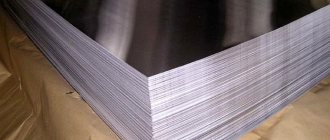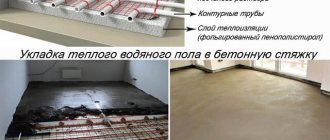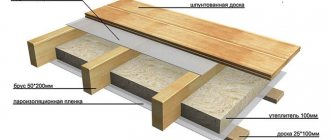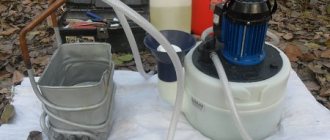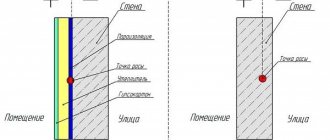Heating systems and equipment are quite expensive. Not every family can afford to purchase a new boiler for installation in their dacha. You will have to spend a significant amount on its purchase and subsequent installation. However, if you wish, you can always make a wood-burning boiler with your own hands that can heat your living space.
In terms of their design, homemade wood-burning boilers can be different. The efficiency of heating and ease of operation depend on their design. Having decided to do everything yourself, you should first pay attention to the simplest design. Pyrolysis wood boilers require certain knowledge and skills. Although their efficiency is much higher.
Homemade boiler for water heating
All self-made heating boilers are based on a general principle: fuel, burning in it, heats the heat exchanger.
That is the coolant, which the vast majority of home craftsmen choose water as. The operation of such a boiler and its appearance directly depend on two main factors: what materials are available and what kind of fuel is the cheapest in your area.
The efficiency of a homemade boiler depends on:
- The design of your heat exchanger - the larger the available area of direct thermal contact of the container with the coolant and the firebox, the greater the amount of heat the coolant receives per unit time.
- Complete combustion of the fuel used - if pyrolysis gas escapes into the chimney along with the resulting combustion products, afterburning which can significantly increase the efficiency, and the flow of oxygen to the combustion site is insufficient - the design needs to be modified.
It directly follows from this that it is necessary to achieve a minimum temperature of combustion products. The lower it is, the higher the efficiency of the boiler.
The second advantage of the low temperature of combustion products entering the chimney is the key to safe and durable operation of your boiler.
For reference: the best models of boilers operating on solid fuel can achieve the indicated indicator in the range from 120 to 150 degrees.
The principle of a boiler for water heating
The principle of a boiler for water heating
Almost the entire variety of existing types of boilers, both factory-made and self-made, use a single principle in their work, which was discussed in the previous section.
It is implemented in two ways:
- A do-it-yourself water heating boiler can be made using the samovar method. The fuel burns inside a container filled with coolant. Most often, this scheme is implemented in the manufacture of a boiler for a Russian bath.
- A homemade water heating boiler made using the second method involves passing the coolant through the pipes of a heat exchanger (coil) through a firebox in which the fuel burns. As a variant of the same method, quite often the heat exchanger is placed immediately behind the firebox at the point where combustion products exit it.
As a rule, preference for one or another option is given taking into account the capabilities of the master in terms of acquiring the necessary materials.
But, in any case, we must not forget that a water heating boiler is a high-risk device and requires constant monitoring during operation.
Therefore, boilers for water heating at home must have in their design a valve to relieve excess pressure, a pressure gauge and a thermometer to determine the temperature of the coolant.
How to make a water heating boiler with your own hands?
Homemade boiler for water heating
The topic of do-it-yourself water heating is almost impossible to expand on in a short review. Therefore, we will give only some recommendations. Those interested can find more detailed information on our website and in other sources.
The most commonly used materials for the manufacture of boilers are sheet steel with a thickness of 4 - 5 mm. Heat-resistant stainless steel is, of course, better. But, having found out the price per sheet, most choose the regular one.
When making a homemade water heating boiler, the master, as a rule, takes into account the existing or future method of circulating coolant in the CO.
If it moves by gravity (gravitational circulation), then it will be necessary to raise the water tank quite high, and use pipes of large diameters for wiring. And both on the supply and return.
This is due to the fact that the resistance to the movement of the coolant is inversely proportional to the diameter of the pipes. If the diameter is not large enough, then you will not be able to do without installing a circulation pump.
Homemade water heating boilers equipped with pumps have their advantages: pipes of smaller diameters are cheaper, the coolant tank can not be raised so high, and disadvantages: if the power supply is lost while the system is operating, the boiler may simply burst due to overheated steam. The choice is yours.
Several recommendations that are suitable for any type of boiler you choose: heating circuits and pipes installed on the heating boiler should preferably be made from pipes with a diameter of 32 mm or more (in inches this is 1 and ¼).
When an emergency stop of the circulation pump occurs, a rapid and sharp increase in water temperature is observed while the speed of its movement decreases.
To avoid failure of the heating circuit, if possible, it is better to make it from galvanized pipes, and seal the connecting threads using flax tow and red lead.
Options and designs of heating boilers
A homemade boiler for water heating is usually divided according to the type of fuel used into the following main types:
Wood boilers
DIY wood heating boiler
Boilers of these types are most in demand for self-production due to the simplicity of their design, the availability of the materials and tools necessary for the manufacture of such a boiler, and the possibility of freely purchasing the required amount of firewood.
- Advantages: simplicity and versatility.
- Disadvantages - rather low efficiency. The following scheme, in this regard, is much preferable.
The simplest version of such a boiler: a thick-walled pipe of large diameter, into which a pipe of smaller diameter is inserted, which is the firebox. The space between the pipes is filled with coolant.
Wood-burning boilers are universal. They can be heated not only with wood, but also with almost any solid fuel. (peat briquettes, coal).
Pyrolysis boilers
In the temperature range from 200 to 800 degrees, wood, the combustion process of which takes place with a lack of oxygen, decomposes into wood coke and pyrolysis gas.
As soon as a sufficient amount of atmospheric air is added to the latter, it ignites, releasing heat in large quantities. This increases the efficiency of boilers of this design to 92%.
One load of fuel (wood) can last a pyrolysis boiler for 12 hours, while for traditional boilers this figure does not exceed 4 hours.
There are practically no solid residues. The combustion of gases can be easily adjusted in automatic mode.
The downside that boilers for water heating a house of this design have is strict requirements for fuel humidity, no more than 30%. Otherwise, when mixed with water vapor, the pyrolysis gas will burn poorly.
Materials for the manufacture of a boiler of this design will cost significantly more. Than the first option. But the entire overexpenditure will be fully recouped in 2 - 3 heating seasons.
Waste oil boilers
The boiler is ignited, brought to operating mode, and oil begins to drip onto a special hot pan, which evaporates almost instantly.
The resulting gases, burning, heat the coolant. Instead of oil, you can use diesel fuel.
Electric boiler
The simplest design is a heating element inside a pipe standing vertically, to which the return is supplied from below and the supply from above. And natural water circulation.
Cons: boilers with a rated power of more than 7 kW are prohibited from connecting to 220 V networks. But 380 Volts are not available everywhere.
The second option for an electric boiler is an induction boiler. This is the simplest version of a homemade boiler of a similar design: a thick-walled plastic pipe on which at least a hundred turns of enameled wire are wound, connected to a portable welding machine with an output current of 15A.
Elements heated by eddy currents (cuts of steel wire, chopped rod, etc.) are poured into the pipe. We connect the return from below, the supply from above, supply water and you can turn on the power.
Peculiarities
Today, heating boilers have sufficient power to heat rooms for various purposes. They are economical. Their continuous operation time is almost the entire heating season.
These devices can operate on wood, coal, pellets (wood waste compressed and processed into granules), briquettes, peat, and wood gas.
Boiler types
Depending on the type of solid fuel, they are divided into the following types:
- wood-burning (heated not only with wood, but also with pellets);
- universal (they use different types of fuel and their combinations for work);
- gas generator boilers (they have increased efficiency and operate on wood and wood gas).
Models of the latter type are more convenient to use, since soot does not accumulate inside them, and a minimum of ash remains.
There are models of long-burning boilers, dependent on the electrical energy carrier and independent.
Such heating equipment operates on the principle of top combustion (the hearth burns from top to bottom). The combustion chamber, located at the top of the structure, is filled with fuel. The fan forces air through the duct, and the heat generated by combustion is sent to the heat exchanger. The volume of the combustion chamber is about 500 dm3, so such a heating device can operate without interruption for several days.
Advantages
Long-burning designs are heating devices that are very popular among the population. This is explained by their many advantages: not only the use of various types of fuel, but also their long combustion time, as well as the simplicity and environmental safety of their use.
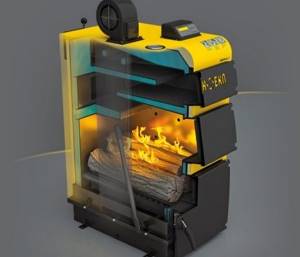
A boiler of this type in its modern variation is a design equipped with automation and a fan to increase the pressure in the system. With a small amount of fuel consumed, such devices can maintain the temperature in large rooms.
The big disadvantage of the design is the high cost, more than 1000 USD. e.
Materials and tools for installing the boiler
The main advantage of the decision to make a water heating boiler with your own hands is that this does not require special equipment, tools and parts.
It is quite easy to find available raw materials and materials, and almost all the tools are available to any owner of his own home (drill, wrenches, screwdrivers...).
To work you will need:
- sheet metal or large diameter pipe (option: metal barrel, old stove, etc.);
- steel pipes;
- radiators (if the coolant is water), profile pipes;
- hardware (nuts, bolts, etc.);
- dampers (you can buy them, find used ones, or make them yourself);
- door.
It is advisable to install the required minimum of automation on the boiler (temperature control and measurement sensors, for example, or a pressure gauge).
The materials used must be of proper quality (no holes, rust, etc.).
It’s a good idea to install a pump to force the coolant to move.
Installing a homemade boiler in a brick oven
Installing a homemade boiler in a brick oven
The installation algorithm for a furnace with a water heating boiler is as follows:
We determine the installation location of the boiler. Then we make markings and pour the foundation.
Preparing masonry mortar for bricks. For it you will need sand and clay in a 2:1 ratio (approximately, may vary depending on the fat content of the clay). Soak the clay overnight, and in the morning, using a mixer (attachment to a drill), mix the sand-clay solution.
We lay a sheet of roofing material or other waterproofing on the finished foundation. In size, it should be at least 10 cm larger than the size of the boiler. Fill it with cement screed on top and level it.
Using ordinary ordinary red brick (not silicate) we lay out the outer contour of the future furnace. You can also put a fight inside.
We bring the walls up to the level of the ash door, put a metal sheet with an outward slope to make it easier to remove the ash.
We fasten the door and lay out the outline of the blower. We install the boiler (by level) and the combustion door. We lay out the chimney.
How to choose the best batteries for heating a house or apartment? There are quite simple methods for calculating parameters.
Heat generators for air heating at home
Heat generators for air heating operate according to the following principle: air forced into the system through fans is gradually warmed up in the heat exchanger
Homemade wood heating boilers
The solid fuel heating system for a house has always been distinguished by the comparative simplicity and accessibility of the design of the devices, as well as the general scheme of operation in terms of heating.
Solar panels for home heating
One of the popular alternative energy devices is solar panels for home heating. They are absolutely harmless to the environment and safe for humans.
Making a wood burning boiler with your own hands
Heating systems and equipment are quite expensive. Not every family can afford to purchase a new boiler for installation in their dacha. You will have to spend a significant amount on its purchase and subsequent installation. However, if you wish, you can always make a wood-burning boiler with your own hands that can heat your living space.
In terms of their design, homemade wood-burning boilers can be different. The efficiency of heating and ease of operation depend on their design. Having decided to do everything yourself, you should first pay attention to the simplest design. Pyrolysis wood boilers require certain knowledge and skills. Although their efficiency is much higher.
Advantages of double-circuit heating
Double-circuit heating is the type of heating in which water is heated using a boiler specifically for use in the home and for heating the entire room. Thus, the entire need for hot water is provided by one double-circuit boiler. There are other reasons why it is gaining more and more popularity:
- Makes it possible not to depend on utilities and allows you to regulate the heating yourself, thereby creating comfort at home
- Possibility of installation in any part of the house. since no additional exhaust system is required, ventilation is also not required
- Apart from the boiler itself, you will not need anything, because everything necessary for heating and supplying the house with hot water for a long time will already be built in
- Favorable and affordable price
How a wood-burning stove with a water circuit works. Choosing fireplace stoves for a summer residence with a water circuit and a heat exchanger. Brick stove with a water circuit. A stove with a water circuit in development - how to do it yourself.
Ordinary boiler
First, let's look at how to make a simple wood-burning boiler with your own hands. The model consists of two cylinders placed inside each other. The first is used as a firebox. When positioned horizontally, it can be lined with fire-resistant bricks from the inside.
The second acts as a convection carrier or is used to heat the coolant. Firewood is placed directly into the firebox.
Available materials
To reduce the amount of welding work, you can use a thick-walled pipe or barrel. It is also possible to use other available materials.
A rectangular firebox welded from a thick sheet can be easily placed inside a cylindrical container.
Design Features
The wood-burning boiler is equipped with a vent for fresh air and a chimney for exhaust gases. The ash pit is located at the bottom of the chimney and allows the bottom row of wood to smolder, generating additional heat. Firewood is placed in homemade boilers through the top. A special hatch is prepared for this purpose.
To ensure that each pile of firewood burns for as long as possible, a special load is often provided, shaped like a disk with blades and a hole with a diameter of 20 mm. When the load is pressed, the burning fuel is compressed. In this case, the volume of incoming air is significantly reduced, since it can only pass through the existing hole.
Connection method
Such a boiler can be connected to the heating system in two ways:
- cutting water pipes directly into the barrel. Circulating between the pipes, it will heat up, so that later, when it enters the heating system, it heats the radiators;
- cutting the chimney into the coolant tank. Exhaust hot gases will enter the container, gradually heating the coolant.
Classic long-burning boiler
In this section, we bring to your attention a homemade heating unit using wood and coal, designed and made by our expert Vitaly Dashko. The master assembled several dozen similar heat generators of varying power to order, constantly improving the design. For a brief overview of the TT boiler, watch the video:
The reliability and efficiency of boilers has already been time-tested at various facilities. The technical characteristics of the presented unit model are as follows:
- power – 22–24 kW;
- burning time (on average) with wood is 10-12 hours, minimum – 8 hours;
- the same, on coal - up to 1 day;
- Efficiency - 75-77%;
- maximum operating pressure in the heating system – 3 Bar, nominal – 1.5 Bar;
- the amount of water in the boiler tank is 50 l;
- product weight - 150 kg;
- loading opening size (width x height) 360 x 250 mm;
- total volume of the firebox - 112 l, useful volume (for loading fuel) - 83 l;
- firebox depth - 46 cm, optimal log length - 40 cm.
For reference. The master manufactures long-burning boilers of various powers; the line includes units of 16, 24, 36 and 130 kW. The price of a finished product for 24 kW when ordering from a specialist is about 450 USD. e. All questions and clarifications related to the design of a solid fuel boiler and its manufacture can be discussed personally with Vitaly, whose contacts are listed on the “Our Experts” page.
The design and overall dimensions of a long-burning wood-burning boiler for DIY production are shown in the drawing:
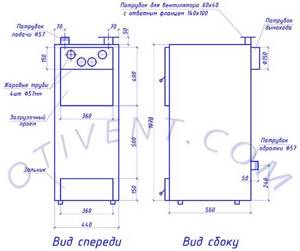
The heat generator operates successfully on both wood and coal fuel. The useful capacity of the firebox is calculated up to the lower edge of the loading opening, since it is undesirable to fill the chamber to the top. The boiler operates in the following order:
- After loading and igniting solid fuel, the doors are hermetically closed.
- The electronic control unit sets the desired coolant temperature; it is recommended not lower than 50 °C. Then the unit is put into operation by pressing the corresponding button, and the fan starts.
- When warming up to the set temperature, the fan turns off and air access to the firebox stops. The TT boiler is in standby mode, the wood smolders very weakly and produces virtually no heat.
- After the temperature in the boiler tank drops, the controller gives a command to start the fan and the combustion process in the furnace resumes.
The controller changes the fan performance at its discretion in order to achieve maximum combustion efficiency. There is no smoldering combustion in this homemade boiler; it is either in a standby state or burns wood and coal in an intensive mode.
The internal structure of the unit is shown in the sectional drawings of the boiler:
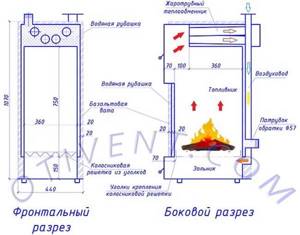
The heating installation implements the classic method of burning solid fuels with direct heat transfer to the walls of the water jacket and the vault, which is the bottom of the boiler tank. A fire tube heat exchanger is immersed in this tank, removing heat from the flue gases. The air heated in the channel is supplied to the firebox from below, through the grate. Burning duration is ensured by:
- Large firebox volume.
- Completely blocking the access of air to the firebox in standby mode. After the fan is turned off, the gravity damper is activated, closing the air duct and thus preventing the chimney draft from blowing up the coals.
The structure of the rear part and the fire tube heat exchanger is shown in the following drawing:
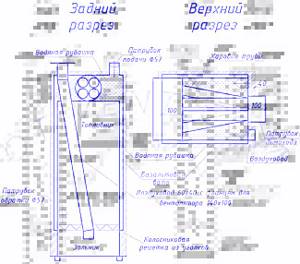
Tools and materials for manufacturing
The blanks for assembling a long-burning solid fuel boiler are usually made from low-carbon steel grades St 3, 10, 20. The best option is St 20; heat generators made from it last up to 15 years. Steel containing more carbon (St 35, 45) tends to heat up at high temperatures, and is therefore unsuitable for welding a heat generator.
If you have sufficient experience in welding and the opportunity to buy more expensive metal, then the combustion chamber can be made of heat-resistant steel alloyed with chromium and molybdenum (for example, 12ХМ, 12Х1МФ). How to independently determine the steel grade with sufficient approximation is described in this article.
The list of blanks from which you will assemble a solid fuel boiler with your own hands is given in the form of a table:

Advice. It is best to cut blanks using guillotine shears somewhere in a workshop. This will save you a lot of time on manual cutting and deburring.
Additionally you will need the following materials:
- equal angle angle 50 x 4 mm for making grate bars;
- pipe DN50 – for the heat exchanger and heating system connection pipes;
- pipe DN150 – to the chimney pipe;
- profile pipe 60 x 40 mm for the air channel;
- steel strip 20 x 3 mm;
- basalt insulation with a density of 100 kg/m³ and a thickness of 2 cm;
- smooth sheet metal 0.3-0.5 mm with polymer painting;
- ready-made door handles;
- cord, asbestos cardboard.
Among the tools, it is worth noting a welding machine, a grinder and a drill; ANO-21 or MP-3S electrodes are used for welding. The rest is a standard set of measuring devices and tools available in every home.

The Polish-made fan and control unit fits any homemade TT boiler
The automation kit used in the TT boiler, consisting of a control unit, fan and temperature sensor, is made in Poland (do not confuse it with the Chinese one, it looks the same). The marking of the control unit is KG Elektronik SP-05, the fan is DP-02.
Assembling the heating unit
The first stage of manufacturing a long-burning boiler consists of assembling the firebox body from metal 4 mm thick by tack welding. It all starts from the bottom of the unit, to which the side walls, vault cover and door openings are attached, as shown in the photo:

The bottom sheet is issued in each direction in accordance with the drawing, at the same time it serves as the lower frame of the ash pan door. Inside the chamber, shelves from the corners are fixed by welding, where the grate will rest. The assembled firebox is thoroughly boiled at all joints and checked for leaks.
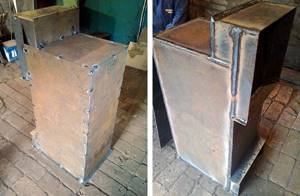
The second stage is the installation of a water jacket made of 3 mm metal. Its thickness at the side walls is 2 cm, so sections of steel strip should be welded to the firebox body, extending them by 20 mm. Steel sheathing sheets are attached to them.

Attention! The water jacket begins at the level of the grate and does not wash the ash chamber.
In the middle, so-called clips are placed in a checkerboard pattern. This is a steel circle passed through holes in the wall of the boiler tank and butt welded to the firebox. The second end of the clip is welded around the hole, as shown in the photo:
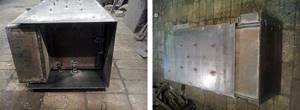
In the photo on the right you can see where the bottom of the water jacket is, on the left - the boiler tank
A few words about how to make additional clips along the edges of the water jacket of a homemade solid fuel boiler. You need to take a 20 mm strip and insert it from the end between the walls to a depth of 50-100 mm, and then weld it on both sides.
The third stage is the installation of flame pipes in the upper part of the boiler tank. To do this, holes are cut in the rear and front walls according to the drawing into which pipes are inserted. Their ends are hermetically welded, like all joints of the water jacket.
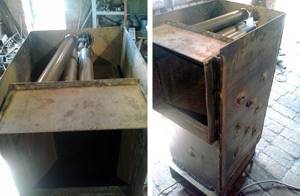
The flame tubes of the heat exchanger fan out from the chimney pipe
The fourth stage is the manufacture of doors and grate. A strip in 2 rows is welded to the inside of the doors, and an asbestos cord is placed between them, this will seal the vestibule. The grate bars are made from corners No. 5, welded with the outer corner down. So they serve as diffusers of air supplied by a fan to the ash pan.

At the fifth stage, fittings are cut into the walls of the boiler tank to connect the supply and return pipelines, a chimney pipe and an air duct from a 60 x 40 mm pipe with a fan mounting flange are installed. The air duct enters the ash chamber in the middle of the rear wall, just below the water jacket.
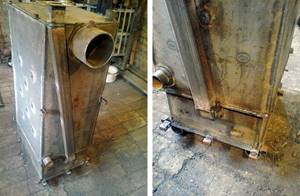
Stage six - welding of door hinges and embedded parts 2 cm wide for attaching the decorative lining of a long-burning boiler.
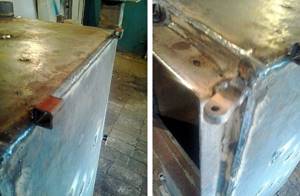
Stage seven , last. The boiler tank is lined on the sides and top with basalt insulation, the latter being secured with a cord. Then all that remains is to screw the sheets of painted metal with self-tapping screws to the embedded parts and install the doors.
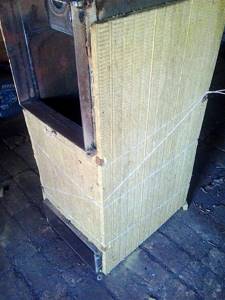
Dense basalt fiber insulates the body well and can easily withstand high temperatures. Glass wool should not be used
At the end, a fan is attached to the counter flange of the air duct, and the control unit is installed on top of the boiler. The temperature sensor must be placed under the basalt insulation on the rear wall of the unit. In addition, a number of useful additions can be made to the design of a homemade long-burning boiler, at your request:
- install a water heating circuit for hot water supply into the boiler tank;
- provide an immersion sleeve for installing a thermometer - in case of a power outage when the controller display goes out;
- the same for installing a security group;
- install an electric heating element that heats the coolant after the wood burns out.
A few words about how to circulate hot water in a solid fuel boiler in order to heat it for household needs. You need to take 10 m of copper tube with a diameter of 8-12 mm and bend a coil from it in the form of a spiral. The latter is wound inside the boiler tank around the flame pipes, and the ends are brought out from the rear side of the unit. We get a long-burning double-circuit boiler.
Note. The practice of operating these heat generators has shown that the installation of an electric heater is necessary for those homeowners who want to heat their house at a nightly rate. In other cases, the burning time is enough to avoid running to the boiler room in the middle of the night to add more firewood.
It is better to remove the film from the painted metal immediately, and cover the doors with heat-resistant enamel.
The legs of the unit can be attached at any stage by selecting suitable pieces of rolled metal.
For details and secrets of assembling a TT boiler, watch the author's video of the master - the creator of the heating unit:
Pyrolysis boiler
The operating principle of solid fuel pyrolysis boilers operating on wood is based on the destruction of wood under the influence of high temperature and low oxygen content. They are used for long-term heating of premises for various purposes.
Such a boiler consists of two chambers. The first is used to load fuel. The second one receives exhaust gases and secondary air for long-term combustion. Making such a unit with your own hands is more difficult than a regular one, but it is possible.
Main elements of the device
A wood-burning boiler is made from a metal barrel. Preferably with a capacity of 200 liters. The lid of the barrel is cut off and the side is welded to it. A round piston is made from a massive billet or any other weighting material. Its diameter should be slightly smaller than the internal diameter of the barrel.
A hole is cut in the cover to install an air duct pipe with a diameter of 100 mm. The height of the pipe should be at least 20 cm higher than the barrel. A chimney pipe is welded into the side of the barrel. It also uses rolled steel with a diameter of 100 mm.
The air pipe is welded to the piston. A damper is provided at the upper end of the pipe to regulate the amount of incoming air. Ribs are welded to the bottom of the piston and are used to compact the fuel mass.
Principle of operation
During operation of the boiler, firewood is loaded directly into the firebox and ignited. A cap with a piston is installed on top. As the fuel burns, the piston will move down, increasing pressure in the lower chamber. Due to this and the minimal amount of oxygen, the firewood will begin to slowly smolder.
The gas released during pyrolysis will enter the upper chamber, the temperature in which can reach 900C. Through the chimney, the remaining combustion products are removed into the atmosphere.
Such home-made boilers, manufactured according to all the rules, are capable of working for more than a day on one bed due to prolonged burning.
Enlargement of the combustion chamber
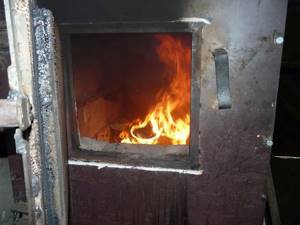
By correctly calculating the size of the combustion chamber and the firewood supply door, you will not only increase the efficiency of the boiler, but also make your life much easier when operating it.
The easiest way to achieve long-term combustion in a wood-burning boiler is to increase the volume of its combustion chamber. Let's assume that we need to heat a household with an area of 100 square meters. m. To do this, we need 2.3 firewood per hour (the average calorific value of wood is about 4.3 kWh/kg. Therefore, in order to achieve long-term combustion for 12 hours, we need a combustion chamber that can hold 28 kg of firewood. With an average wood density is 1.73 kg/dm³, the approximate volume of the chamber will be 16.18 liters.
Since we are interested in loading for 24 hours, the volume of the combustion chamber will be 32.26 liters. But you need to take into account that firewood is far from water. They do not occupy the entire space, so we can safely multiply the resulting value by two - the total will be about 65 liters. It is also necessary to leave a reserve for normal combustion, so that there is room for the flame to rage, although here everything depends on the design of the boiler.
When calculating the dimensions of the combustion chamber, focus on the length of the logs - this will help create a firebox that is convenient for loading.
It becomes obvious that to realize ultra-long combustion it is necessary to create a very large combustion chamber. And in order to further increase the efficiency and duration of combustion of one portion of fuel, you should use certain types of wood - we recommend choosing birch and oak. Despite the fact that their calorific value is lower than that of the same pine, these types of wood are denser. And they burn at a higher temperature (almost +900 degrees).
Preparing material and tools
When starting to make a wood-burning boiler with your own hands and trying to complete everything in the shortest possible time, you should take care of the availability of:
- diagrams of the future boiler;
- steel pipes of various lengths, diameters (400, 500, 100 and 150 mm);
- steel sheet with a thickness of at least 4 mm;
- rolled products for making legs;
- two hundred liter barrel;
- heat-resistant mixture used for laying stoves and fireplaces;
- welding machine;
- electrodes of a suitable brand and size. As a rule, electrodes with a diameter of 3–4 mm are used to perform welding work;
- Bulgarians.
Advantages and disadvantages
Due to its large dimensions and complexity of the design, it is rational to use such a unit for heating a large cottage. But for a small dacha this option is not suitable, as it does not justify the cost-effectiveness.
pros
- high efficiency (about 95%);
- autonomy of the heating system;
- efficiency;
- reliability and durability;
- high efficiency;
- fuel availability;
- an environmentally friendly option for heating your home;
- versatility of fuel (coals, firewood, sawdust, pellets).
Read our material about which long-burning boilers are better.
Minuses
- cumbersome design;
- a special room must be equipped for the device;
- complexity of design and installation;
- the need for constant cleaning.
It is not necessary to buy a long-burning boiler ready-made, because its price is several times higher than conventional stoves. You can make such a design yourself if you have at least a little experience in construction and repair.
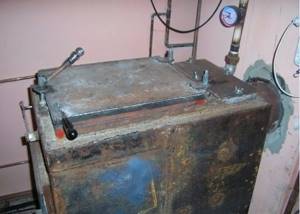
Appearance of a homemade structure
A homemade design, compared to a factory-made analogue, has a number of advantages:
- low cost;
- the ability to make the boiler universal for any type of fuel;
- possibility of improving the design and adding power.
The only difficulty is giving the boiler a cylindrical shape. It is very difficult to give metal such a shape without a rolling machine.
But there is a good solution. You can use empty propane tanks or any pipe of suitable diameter. You should choose pipes with a wall thickness of at least 5 mm.
For a village or a small dacha, you can build a small brick stove and enjoy its efficiency. But for a large cottage, this option will be less practical, as it will require a large supply of firewood for the winter. Caring for a conventional stove, compared to a long-burning boiler, is much more difficult, and large temperature changes in rooms remote from the stove do not allow organizing a comfortable microclimate in the house.
If you do not have enough money to create a full-fledged heating system for your home, or the construction of such a system itself is impractical, it would be much more reasonable in this situation to make a long-burning solid fuel boiler with your own hands and not worry about its safety and aesthetic appearance.
Build process
The process of creating a boiler includes several stages. When manufacturing each element, it is worth taking into account the special operating conditions of the product being manufactured.
Air supply device
We cut a section from a thick-walled pipe with a diameter of 100 mm, the length of which will be equal to the height of the firebox. We weld a bolt to the bottom. From a steel sheet we cut out a circle with the same diameter as the pipe or larger. We drill a hole in the circle large enough to pass the bolt welded to the pipe. We connect the circle and the air duct pipe by tightening the nut onto the bolt.
As a result, we will get an air supply pipe, the lower part of which can be closed by a freely moving metal circle. During operation, this will allow you to regulate the intensity of firewood combustion and, consequently, the temperature in the room.
Using a grinder and a metal disc, we make vertical slits approximately 10 mm thick in the pipe. Through them, air will flow into the combustion chamber.
Housing (firebox)
The body will require a cylinder with a sealed bottom with a diameter of 400 mm and a length of 1000 mm. The dimensions may be different, depending on the available free space, but sufficient for laying firewood. You can use a ready-made barrel or weld the bottom to a thick-walled steel cylinder.
Sometimes heating boilers are made from gas cylinders for a longer service life.
In the upper part of the body we form a hole for the removal of gases. Its diameter must be at least 100 mm. We weld a pipe to the hole through which the exhaust gases will be removed.
The length of the pipe is selected depending on design considerations.
Connecting the housing and the air supply device
We cut a hole in the bottom of the housing with a diameter equal to the diameter of the air supply pipe. We insert the pipe inside the body so that the air vent extends beyond the bottom.
The air supply pipe should end a few centimeters before the start of the chimney.
Heat Dissipation Disc
We cut out a circle from a metal sheet 10 mm thick, the size of which is slightly smaller than the diameter of the body. We weld a handle made of reinforcement or steel wire to it.
This will greatly simplify the subsequent operation of the boiler.
Convection hood
We make a cylinder from sheet steel or cut a piece of pipe, the diameter of which is several centimeters larger than the outer diameter of the firebox (body). You can use a pipe with a diameter of 500 mm. We connect the convection casing and firebox together.
This can be done using metal jumpers welded to the inner surface of the casing and the outer surface of the firebox, if the gap is large enough. With a smaller gap, you can weld the casing to the firebox around the entire perimeter.
From a steel sheet we cut out a circle with the same diameter as the firebox or a little larger. We weld the handles to it using electrodes, wire or other available means.
Considering that the handles can become very hot during operation of the boiler, it is worth providing special protection made of material with low thermal conductivity.
To ensure long burning, we weld the legs to the bottom. Their height should be sufficient to raise the wood-burning boiler at least 25 cm above the floor level. To do this, you can use various rolled products (channels, angles).
Congratulations, you have made your own wood-burning boiler. You can start heating your home. To do this, just load the wood and light it by opening the lid and heat dissipation disk.
Self-production
It is quite difficult to construct a heating boiler with your own hands. The slightest inaccuracy and it will not work correctly, which can lead to tragedy. Therefore, it is necessary to carefully study the technology of their manufacture and carry out all activities very efficiently.
Shaft-type heating devices
You can create a mine or pyrolysis boiler yourself. The first operates not only on wood, but also on coal, peat or sawdust. You can immediately load up to 50 kg of firewood into its chamber.
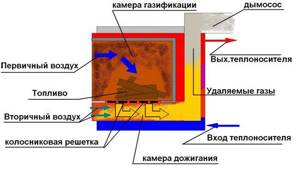
When the chamber is fully loaded with fuel and high power, such a device will work continuously for up to 5 hours, at the lowest power (15-20 kW) - up to a day. Its efficiency is 75%. The power of such models can be adjusted automatically.
Pyrolysis model
Yellow or colorless wood gas, released under high temperature, is the heat source in the pyrolysis boiler. For such a heating device, you can only use completely dried firewood, otherwise it will not start. The pyrolysis design can also operate on pellets. Their automatic feeding into the furnace (using special augers) will be an additional advantage of the boiler. The operating time of a model of this type when fully loaded is 12 hours.

Disadvantages - high cost (you can reduce it if you make it yourself), energy dependence (the fan runs using electricity), large size. To make such a device you need:
- pipe and sheet of steel 4 mm thick;
- professional pipes, metal rods with a cross-section of 2 cm;
- electrodes;
- fan;
- fire bricks;
- automatic temperature controller;
- fasteners.
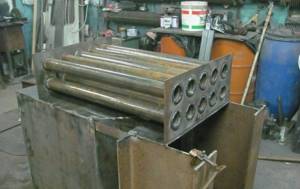
They first draw up a diagram of the future boiler with all the calculations. The most successful design of a homemade boiler in this regard, developed by engineer Belyaev, is taken as a basis. Adjustments are made to it according to the wishes of the home owner. For example, heating can be made more efficient by increasing the volume of the heat exchanger jacket.
Homemade pyrolysis devices must be installed on fireclay brick platforms specially equipped for them. After this, they are connected to the water circuit.

During the first test switch-on, they find out whether there were any errors in the boiler design. If everything was done correctly, the device can quickly switch to gas generator mode. The room will become much warmer within half an hour.
Tools and materials
A wood heating device is the safest design. Its autonomy, ease of operation, minimal risk of explosion, and the possibility of self-production are its main advantages. Its disadvantage is the regularity of adding fuel.
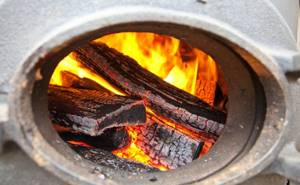
Homemade wood-burning boiler models can be made from the following materials and parts:
- metal barrel (volume – 200 l);
- steel sheet 3-5 mm thick (to create a firebox);
- metal pipe with a diameter of 20 mm and a wall thickness of 3 mm;
- L-shaped pipe (diameter – 20 mm);
- grate;
- doors for the vent and firebox.
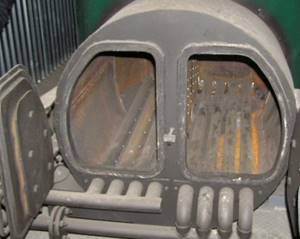
Homemade models of wood-burning boilers are made using gas welding equipment and an angle grinder.
Sequence of work
Before starting work, you must carefully consider the design of the device, purchase all the necessary materials and tools.
Cut 3 circles (diameter of each 57 cm): this is the bottom, the top cover and the partition between the ash pit and the firebox. Make a hole with a diameter of 20 mm in two of them.
A strip 400 mm wide and 3600 mm long was cut from a sheet of steel, holes were cut in it for the firebox door, and below it for the ash pan. Weld the sheet together into a circle.

Weld a circle with a hole on top and without one on the bottom. Install a partition with a grate between them.
Weld the pipe and the barrel together according to the “one inside the other” principle. Install a firebox with a blower underneath. Connect all elements by welding.
Attach an L-shaped piece of pipe to the top of the barrel: it will connect the heating container and the chimney. When water heats up in a barrel, it forms steam, which will freely escape into the chimney, thereby preventing the pressure in the boiler from increasing.
Install pipes at the top and bottom for cold water inlet and hot water outlet.
Hang the doors on the firebox and vent.
Install the structure on a foundation made of refractory bricks.
Such a device heats using firewood, pellets or peat, tightly packed inside the firebox.
Even the simplest model of a wood-burning boiler requires care and attention when making it yourself
Wood heating water boiler
Autonomous heating is gaining great popularity not only among owners of private or country houses, but also among residents of multi-storey buildings. Not everyone can afford to buy an expensive gas boiler, and besides, the work of installing it will also cost a pretty penny. Homemade wood heating boilers are an excellent alternative to a gas boiler. A wood-fired water heating boiler is most effective in small private or country houses. Such boilers will allow not only to organize a heating system, but also a hot water supply system.
Most modern boilers run on fuel such as gas, but the house does not always have access to a gas main and the home owner cannot always afford to buy expensive equipment. A wood-burning boiler will help solve the problem of heating your home. An electric boiler is also quite expensive; moreover, a powerful boiler requires more powerful wiring, and electricity is not cheap these days.
What parts does a solid fuel boiler consist of?
Before you start working on the boiler, you need to understand its operating principle. Main elements of the boiler design:
- The combustion chamber is a chamber into which fuel is placed and where the combustion process occurs.
- The heat exchanger is the main structure of the boiler through which the coolant passes and, after heating, enters the heating system.
- The body is a structure that contains all the components of the boiler.
Independent creation of heating boilers for the home is usually limited to a simple design, but nevertheless has two design options: brick and metal.
Let's consider each option in detail.
We create a heating boiler using wood with our own hands
Sometimes such devices are in no way inferior to industrial models - both in terms of efficiency and power parameters. At home, if you follow certain rules and have the necessary experience and knowledge, you can make a wood-fired water heating boiler of the most complex design, which in its performance characteristics can surpass a factory-assembled device.
The manufacture of the boiler will also depend on how accurately the calculations are made.
In order to make a flow-through heating boiler using wood, you will need materials that are easy to obtain and that owners of private houses often have on hand. Particular attention should be paid to such points as calculating the operating temperature of the boiler, metal thickness and others. If the metal is too thin or the operating temperature of the boiler is too high, the metal may burn out.
A homemade boiler for water heating using wood can also be made from old or decommissioned boilers that were previously used in a boiler room or in steam locomotives. This way you will get a device that already meets many of the given conditions. A do-it-yourself water heating boiler can also be made from a device such as a ready-made wood-burning stove. You can go to the points where scrap metal is accepted, to the nearest landfills, and get a boiler for a small amount or completely free. Homemade water heating boilers will then cost many times less than a factory-assembled boiler.
Advantages of a homemade wood boiler:
- Highly environmentally friendly.
- High efficiency rate;
- Available fuel and low cost of the boiler;
- Boiler safety;
- Simple operating conditions;
- Autonomous installation.
Making a water circuit
You yourself can easily install and make a water boiler on a ready-made long-burning water stove, and if you don’t have one, then it won’t be too difficult to lay it out of brick yourself. For heating water. You can make a water circuit from old cast iron heating radiators, which you can easily find.
Their capacity is on average one and a half liters. You can connect several of these together and get a heater with a volume of 15 liters at the output, but due to its large dimensions it may not be suitable for use in all rooms. The most acceptable option is a Russian bathhouse.
First, disassemble it yourself. clean and rinse them with hydrochloric acid, or rather its solution. Before installing the entire structure, the gaskets separating the sections should be changed, since initially they are not adapted to high temperature changes. which can reach more than five hundred degrees. Since the old separator will not hold up and the radiator may leak, use impregnated asbestos cord for installation. After this you can start assembling. It must be assembled in such a way that the exit pipe is located above the entire structure, and the entrance pipe is located under it.
Place the circuit ready for use in the chimney as close to the firebox as possible. The hot air coming from there will heat the circuit and, accordingly, the water, making it suitable for heating the house. Subsequently, you will connect the entire water circuit system to the radiators that heat your home
Be sure to first check the entire system for any leaks, paying particular attention to the circuit. which you assembled with your own hands
If you have not found old cast iron batteries for its manufacture, then you can use ordinary pipes for the circuit, but with fairly thick walls.
The water circuit can be applied to absolutely any long-burning stove: from a fireplace to a potbelly stove. You can also make a boiler from fairly thick metal and place it directly under the firebox, which will make it heat up much faster.
Types of homemade wood heating boilers
The most important difference between homemade boilers of this type and factory-made devices is the method of fuel combustion. The classic version of such a boiler has only one combustion chamber into which fuel is placed.
Pyrolysis boilers for water heating at home are devices that are equipped with two chambers and therefore have higher heat transfer.
In the upper chamber of such a boiler, combustion of gases will occur that come from the lower chamber, which is intended for burning wood in it. Such water heating boilers have higher efficiency rates. Heating a house with such a boiler is much easier and faster.
For pyrolysis boilers, it is necessary to use wood as fuel, the moisture content of which should not exceed 20%. Otherwise, the wood simply will not burn and the heating system will not function.
Consumables and tools needed to install a homemade boiler
After all the calculations have been carried out, you can begin installing the heating system. To do this you will need the following tools and materials:
- Steel pipes;
- Rod with a cross section of 20 mm;
- Profile pipes;
- Centrifugal fan;
- Various nuts and bolts;
- Steel sheet;
- Fireclay brick.
Homemade water boilers for heating can be designed in different ways. To do this you need to have the following knowledge:
- How to correctly and accurately choose a place to fire a homemade boiler;
- How to most accurately calculate the operating parameters of a heat exchanger;
- Calculate the most efficient and optimal water supply option.
You can find quite a lot of information, including from those craftsmen who have already installed a water heating boiler in their home with their own hands.
Any option for organizing a heating system that you find can be improved or altered to suit your needs. The most important thing is to make the correct calculation and install the boiler for steam or water heating in the correct way.
Boiler installation
If all calculations have been completed and the boiler design is completely completed, you can begin installing it. Let's take Belyaev's method as a calculation device. The internal volume of the device should be the same, but the volume of the heat exchanger jacket can be increased in order to improve the efficiency of the boiler. After the homemade boiler for water heating is installed in the place prepared for it, it will need to be connected to the water circuit. Next comes a visual check, if all the joints are sealed and if everything is fine, you can try to start the water heating boiler using wood.
The most effective release of thermal energy will begin when the water heating boilers enter gas generator mode. In order to heat the room, such a boiler will take from 20 to 30 minutes.
Once the installation is complete, wood-fired water heating boilers can be painted with paint that has good fire resistance. This will give the structure an aesthetic and attractive appearance.
If the water heating boiler was assembled correctly, and all calculations of the heating system were carried out with maximum accuracy, then such water heating boilers for heating will be more efficient than gas boilers with a low level of efficiency or electric wood-burning units. Wood-burning steam heating boilers are more economical, and with their help you can distribute heat in the room in the most convenient way for you.


